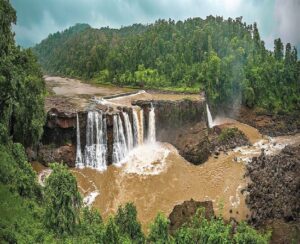 Tribals dancing at a festival in the Dangs
Tribals dancing at a festival in the Dangs
If there’s one word that aptly describes Dangs, a mesmerising region in the western Indian state of Gujarat, it’s pristine. It will be safe to say that Dangs has continued to stay untouched, natural and wild all this while.
The zone is rich in wildlife and natural resources and is home to a number of indigenous tribes that call Dangs their home. It’s these native communities that render Dangs a uniqueness that is rare in India and make it a culturally diverse region.
The zone is also a very historic one and has mention in the famous ancient Indian Sanskrit epic Ramayana. Apart from the rich history, the diverse natural and cultural heritage makes Dangs an enigmatic place and a popular tourist destination.
The location
Dangs district is situated in the south-eastern part of the Gujarat and is skirted by the state of Maharashtra and the Union Territory of Dadra and Nagar Haveli. The region is famous for many tourist places including Saputara, Ahwa, Mahal, Don, Waghai, etc. The monsoon season in Dangs is extremely wet and usually lasts from June till September.
The least populated district of Gujarat, Dangs has its administrative headquarters located in Ahwa. It spans across an area of 1,766 sq km has a population of 2,28,291 persons. Of the entire district area, 1,008 sq km is covered in forest providing Dangs a treasure trove of natural resources.
The number of indigenous people in the state is very high. The gender ratio in the district is 1,006 (Females per 1000 Males) and the ST population stands at 94.65 per cent i.e., 2,16,073 people. Almost 90 per cent of the population of the district lives in rural households.
To reach Dangs, one has to reach one of the bigger neighbouring cities like Surat, Navsari, etc. The nearest airport to reach Dangs is situated in the South Gujarat city of Surat, 141 km away from Ahwa.
Those travelling by road have to use National Highway No. 350 or State Highway No. 14 – while the former passes through Waghai in Dangs, the State Highway goes through Ahwa. Almost all the State Transport buses that intersperse through Dangs connect it to Ahmedabad, Surat, Nashik, etc.
The nearest railway stations to reach Dangs are Surat, Navsari and Valsad in South Gujarat. Dangs does not have broad-gauge railway network as yet. However, narrow-gauge trains do run through the area.
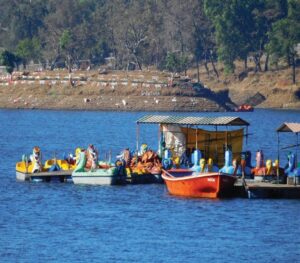 Tourists visit Saputara Lake for boating
Tourists visit Saputara Lake for boating
History and heritage
Dangs has a history that dates back to ancient times. In Ramayana, Dangs has been mentioned as Dakaranya or Dandak. They say, it’s this connection with Ramayana that explains why the folklore of Dangs is ripe with anecdotes from the lives of Lord Ram and Sita. Another Hindu epic, Mahabharat too has mention of Dangs. It is believed that during their exile, the Pandavas roamed through Dangs and lived there as well.
There is a pilgrimage site in Dangs called Shabari Dham, surrounded by hills and forests. It is dedicated to one of Lord Ram’s biggest devotee, Shabari. It is believed that Shabari Dham is the place where Shabari meditated.
Later, many dynasties ruled Dangs, over centuries and decades, making it a culturally diverse region that it is today. These include the Mauryans, King Satya Vahan, Kahatra and Abhir kings and the Chanakya dynasty.
Later, the Chalukyas, Marathas and the British too ruled the region. In 14th century, the kings who ruled Dangs at the time, broke existing allegiance and became independent. Interestingly, in 1664, when Shivaji attacked Surat, he had set his military base in this region only.
Until the time of the formation of the state of Gujarat in 1960, Dangs was a part of the Bombay Presidency.
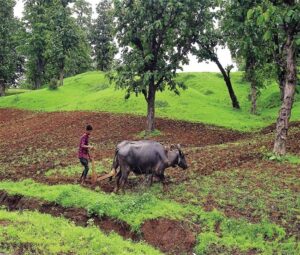 A villager ploughing his field in the Dangs
A villager ploughing his field in the Dangs
The indigenous people
Dangs is as much known for its natural environs as its rich cultural heritage. It is home to several indigenous tribes and has a unique blend of traditional and modern lifestyles. Originally, it were the Kunbi and Bhil tribes that inhabited the region.
Despite overwhelming similarities in customs, culture, appearance and lifestyle, each tribe here has distinct characteristics that differentiate one from another. These customs and characteristics have been passed down from one generation to the next, over centuries, and form a part of the rich heritage that each native community possesses and retains through its customs and lifestyle.
Other than the Bhils and Kunbis, there are the Warli and Gamit tribes that reside in Dangs. Some like the Warli are known for their unique art-work called Warli painting, others are known for crafts like embroidery, bamboo work, etc.
Warli artwork or paintings are usually made on the walls or the floors of houses and use geometrical shapes in abundance. These works depict scenes from the daily lives of the Warli people – hunting, farming, etc.
One of the major events where the various tribes of the region come together is the Dangs Darbar. It is an annual cultural fiesta that takes place in Ahwa in the Saputara Hills and lasts for a few days.
Dangs Darbar is usually observed in March or April, around the time of another big festival Holi or Shimga, as it is popularly known in the region. It’s a great time to see the various tribal people of Dangs dressed in traditional attire and exhibiting their unique dance, music, artwork, instruments, etc.
Warli and Bhil tribes are the prominent tribes of Dangs. While the Warli people are known for their artwork, the Bhils are known for martial skills. There is a significant Warli population in Maharashtra in Thane and Palghar district. As far as the Bhils, they are also found in Surat, Vadodara, Broach or Bharuch, Banaskantha, Sabarkantha, etc.
Folk songs and dances form an integral part of tribal life and their cultural heritage. Kunbi tribe, on the other hand, is mostly involved with farming and the members are skilled artisans creating exquisite handicrafts and folk-art including weaving, pottery, etc.
One of the best ways to experience and observe tribal culture is by participating in one of the many tribal festivals that are celebrated in Dangs. Some of these include Bhagoria, Pola, Pachvo, Tera, Mavlidevi, Diwasa, Pitra or Sira Puja, Wagh Baras and more. In fact, Navratri too is celebrated with fervour in Dangs.
Saputara for all
There is something for everyone in Dangs. Some of the popular destinations include Don Hill, Botanical Garden in Waghai, Mayadevi Temple, Pandava Cave or Aravalem Caves in Saputara, Devinamal Temple, Ataladham Anjani Parvat (Anjan Kund), Shabridham and Pampa Sarovar, etc.
In terms of adventure tourism, there’s Paragliding, Ropeway, Boating and Zipline adventures available in Dangs, particularly in Saputara. Other popular tourist destinations of Dangs district include Saputara Hill Station, Giradhod Waterfalls, Mahal area, Vansda National Park, Purna Wildlife Sanctuary, etc.
Saputara Hill Station is situated about a thousand metres above sea level. It is situated along the banks of the Sarpaganga River and is one of the most popular tourist destinations in Dangs. Many tourists from Gujarat and neighbouring Maharashtra visit the hill station known for its adventure activities like paragliding, boating, trekking, camping, etc.
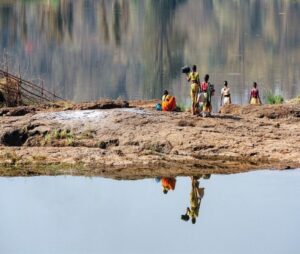 Local tribal women washing clothes near Purna Sanctuary
Local tribal women washing clothes near Purna Sanctuary
Gujarat’s only hill station, Saputara is cosily tucked in the Sahyadri range of the Western Ghats. The hill town also has Saputara Lake, Nageshwar Mahadev Temple, picturesque vista points like Sunrise Point, Sunset Point, Table Point, Gira Waterfalls, etc., which are frequented by visitors and tourists.
The Ropeway Cable Car experience is a must-do while visiting Saputara. The Ropeway, also known as Pushpak Ropeway, can be taken from Sunset Point to Sunrise Point. The minutes-long ride offers a view of the breath-taking Sahyadri valley on one side and the town on the other, as it takes the riders above the bright, blue Saputara Lake.
Saputara Tribal Museum or Saputara Museum is a great place for history, art and culture enthusiasts. The artefacts at display at the museum, established in 1970, represent the lives and the culture of the tribes inhabiting the Dangs region. These include the Bhils, Kunbis, Warlis, Gamits, among others.
The museum is home to more than 400 artefacts and handicrafts of the Dangi tribals and is a big hit among tourists who visit Saputara. The main type of artefacts in display includes ornaments, costumes, tools and musical instruments. Music plays a very important part in the life of a tribal. Even outside the museum, one may chance upon a Warli tribal playing a musical wind instrument called Pawari, just like that!
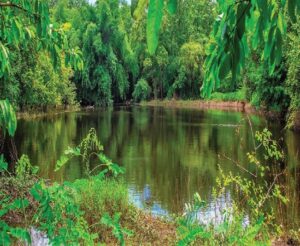 Forests in Dangs are extremely rich in biodiversity
Forests in Dangs are extremely rich in biodiversity
Forests and waterfalls
In a district where more than half of the area is covered in forests, there are ample opportunities and avenues to enjoy nature at its best, especially in Purna Wildlife Sanctuary and Vansda National Park.
Forests in Dangs are extremely rich in biodiversity and are home to several species of flora and fauna. As a result, it is an eco-sensitive zone and critical in maintaining the ecological balance of the zone.
The forests are also rich in plants with medicinal value and are often used by the locals as traditional medicine. Common trees in the forest include teak, sal, bamboo, sisham, kadaya, khair, etc. Among the birds and animals, Dangs’ forests have hornbills, parakeets, woodpeckers, owlets, antelopes, mongooses, leopards, hyenas, etc.
Vansda National Park, or Bansda National Park as it’s also known, is situated in the Vansda forest range covering an area of around 24 sq km along the Ambika River. The rich biodiversity of the forest includes hornbills, peafowl, deer, leopards, etc. Many people come here to hop on to the several trekking trails and enjoy nature in its truest form.
Purna Wildlife Sanctuary is situated in between the Western Ghats and in the 161 sq km area encompasses rolling hills, valleys, plateaus, parts of Purna River and a few rivulets. It was declared as a sanctuary in July 1990.
The vibrant green zone is home to the Bhils, Kokanas, Kolchas, Warlis among others. Many tourists visit the forested sanctuary to rejuvenate and be close to nature. Mahal, a village situated in the sanctuary, is a popular camping destination. Here, several animals inhabit the forest and the campsite, managed by the forest department, offers facilities for tourists including tree house, huts, etc.
Gira Waterfalls are located near Waghai and are also surrounded by dense forests typical to the Dangs landscape. The 30-metre-high waterfall has the water falling on rocky steps giving it a cascading effect.
Located on the border of Gujarat and Maharashtra, Wilson Hills are also popular among tourists visiting Dangs. The hills lie among dense forests and offer mesmerising view of the surrounding valleys.
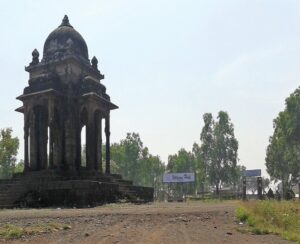 Wilson Hill- A monument has been built in memory of King Vijay Dev and Lord Wilson
Wilson Hill- A monument has been built in memory of King Vijay Dev and Lord Wilson
Interestingly, Wilson Hills, the popular hill station has been named after Lord Wilson – the Governor of Mumbai from the year 1923 till 1928. It was named so by King Vijay Dev – the last king of Dharampur. The two had envisioned developing the hills into a hill station but the plans could not materialise. Today, there’s a monument here in memory of King Vijay Dev and Lord Wilson.


